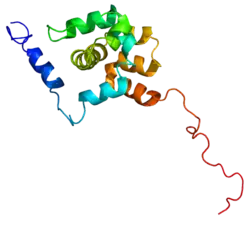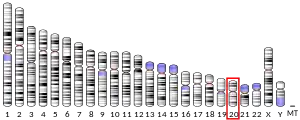ADRM1
Proteasomal ubiquitin receptor ADRM1 is a protein that in humans is encoded by the ADRM1 gene.[5][6] Recent evidences on proteasome complex structure confirmed that the protein encoded by gene ADRM1, also known in yeast as 26S Proteasome regulatory subunit Rpn13 (systematic nomenclature for proteasome subunits), is a subunit of 19S proteasome complex.[7][8]
| ADRM1 | |||||||||||||||||||||||||||||||||||||||||||||||||||
|---|---|---|---|---|---|---|---|---|---|---|---|---|---|---|---|---|---|---|---|---|---|---|---|---|---|---|---|---|---|---|---|---|---|---|---|---|---|---|---|---|---|---|---|---|---|---|---|---|---|---|---|
 | |||||||||||||||||||||||||||||||||||||||||||||||||||
| |||||||||||||||||||||||||||||||||||||||||||||||||||
| Identifiers | |||||||||||||||||||||||||||||||||||||||||||||||||||
| Aliases | ADRM1, ARM-1, ARM1, GP110, adhesion regulating molecule 1, PSMD16, ADRM1 26S proteasome ubiquitin receptor | ||||||||||||||||||||||||||||||||||||||||||||||||||
| External IDs | OMIM: 610650 MGI: 1929289 HomoloGene: 10513 GeneCards: ADRM1 | ||||||||||||||||||||||||||||||||||||||||||||||||||
| |||||||||||||||||||||||||||||||||||||||||||||||||||
| |||||||||||||||||||||||||||||||||||||||||||||||||||
| |||||||||||||||||||||||||||||||||||||||||||||||||||
| |||||||||||||||||||||||||||||||||||||||||||||||||||
| |||||||||||||||||||||||||||||||||||||||||||||||||||
| Wikidata | |||||||||||||||||||||||||||||||||||||||||||||||||||
| |||||||||||||||||||||||||||||||||||||||||||||||||||
Gene
The gene ADRM1 encodes one of the non-ATPase subunits of the 19S regulator base, subunit Rpn13. The human PSMD4 gene has 10 exons and locates at chromosome band 20q13.33.The human protein Proteasomal ubiquitin receptor ADRM1 is 42 kDa in size and composed of 407 amino acids. The calculated theoretical pI of this protein is 4.95.[9]
Structure
The protein encoded by this gene is an integral plasma membrane protein which promotes cell adhesion. The encoded protein is thought to undergo O-linked glycosylation. Expression of this gene has been shown to be induced by gamma interferon in some cancer cells. Two transcript variants encoding the same protein have been found for this gene.[6]
Complex assembly
26S proteasome complex is usually consisted of a 20S core particle (CP, or 20S proteasome) and one or two 19S regulatory particles (RP, or 19S proteasome) on either one side or both side of the barrel-shaped 20S. The CP and RPs pertain distinct structural characteristics and biological functions. In brief, 20S sub complex presents three types proteolytic activities, including caspase-like, trypsin-like, and chymotrypsin-like activities. These proteolytic active sites located in the inner side of a chamber formed by 4 stacked rings of 20S subunits, preventing random protein-enzyme encounter and uncontrolled protein degradation. The 19S regulatory particles can recognize ubiquitin-labeled protein as degradation substrate, unfold the protein to linear, open the gate of 20S core particle, and guide the substate into the proteolytic chamber. To meet such functional complexity, 19S regulatory particle contains at least 18 constitutive subunits. These subunits can be categorized into two classes based on the ATP dependence of subunits, ATP-dependent subunits and ATP-independent subunits. According to the protein interaction and topological characteristics of this multisubunit complex, the 19S regulatory particle is composed of a base and a lid subcomplex. The base consists of a ring of six AAA ATPases (Subunit Rpt1-6, systematic nomenclature) and four non-ATPase subunits (Rpn1, Rpn2, and Rpn10.[10] Thus, Proteasomal ubiquitin receptor ADRM1 (Rpn13) is an important component of forming the base subcomplex of 19S regulatory particle. Traditional view of Rpn13 is that it is rather an associating partner of proteasome complex than a constitutive subunit. However, emerging evidences suggested that Rpn13 is a novel subunit of 19S.[11][12] A recent study provided new evidences of 19S complex structure via an integrative approach combining data from cryoelectron microscopy, X-ray crystallography, residue-specific chemical cross-linking, and several proteomics techniques. In the newly established sub complex model of 19S base, Rpn2 is rigid protein located on the side of ATPase ring, supporting as the connection between the lid and base. Rpn1 is conformationally variable, positioned at the periphery of the ATPase ring. The ubiquitin receptors Rpn10 and Rpn13 are located further in the distal part of the 19S complex, indicating that they were recruited to the complex late during the assembly process.[7]
Function
As the degradation machinery that is responsible for ~70% of intracellular proteolysis,[13] proteasome complex (26S proteasome) plays a critical roles in maintaining the homeostasis of cellular proteome. Accordingly, misfolded proteins and damaged protein need to be continuously removed to recycle amino acids for new synthesis; in parallel, some key regulatory proteins fulfill their biological functions via selective degradation; furthermore, proteins are digested into peptides for MHC class I antigen presentation. To meet such complicated demands in biological process via spatial and temporal proteolysis, protein substrates have to be recognized, recruited, and eventually hydrolyzed in a well controlled fashion. Thus, 19S regulatory particle pertains a series of important capabilities to address these functional challenges. To recognize protein as designated substrate, 19S complex has subunits that are capable to recognize proteins with a special degradative tag, the ubiquitinylation. It also have subunits that can bind with nucleotides (e.g., ATPs) in order to facilitate the association between 19S and 20S particles, as well as to cause confirmation changes of alpha subunit C-terminals that form the substate entrance of 20S complex. Rpn13 is one essential subunit of 19S regulatory particle and it contributes to the assembly of the "base" subcomplex. In the base sub complex, Rpn13, as a ubiquitin receptor, offers a docking position for ubiquitinated substrate. Evidence showed that ubiquitination of Rpn13 subunit can significantly reduced the proteasome's ability to bind and degrade ubiquitin-conjugated proteins.[14] Investigation employing biochemical and unbiased AQUA-MS methodologies offered evidences showing that, although the vast majority (if not all) of the double-capped 26S proteasomes, both 19S complexes, contain the ubiquitin receptor Rpn10, only one of these 19S particles contains the additional ubiquitin receptor Rpn13, thereby defining asymmetry in the 26S proteasome.[15] Such structural asymmetry might be the molecular foundation for the one-directional substrate feeding process of proteasome complex.
References
- GRCh38: Ensembl release 89: ENSG00000130706 - Ensembl, May 2017
- GRCm38: Ensembl release 89: ENSMUSG00000039041 - Ensembl, May 2017
- "Human PubMed Reference:". National Center for Biotechnology Information, U.S. National Library of Medicine.
- "Mouse PubMed Reference:". National Center for Biotechnology Information, U.S. National Library of Medicine.
- Shimada S, Ogawa M, Takahashi M, Schlom J, Greiner JW (Jul 1994). "Molecular cloning and characterization of the complementary DNA of an M(r) 110,000 antigen expressed by human gastric carcinoma cells and upregulated by gamma-interferon". Cancer Research. 54 (14): 3831–6. PMID 8033103.
- "Entrez Gene: ADRM1 adhesion regulating molecule 1".
- Lasker K, Förster F, Bohn S, Walzthoeni T, Villa E, Unverdorben P, Beck F, Aebersold R, Sali A, Baumeister W (Jan 2012). "Molecular architecture of the 26S proteasome holocomplex determined by an integrative approach". Proceedings of the National Academy of Sciences of the United States of America. 109 (5): 1380–7. doi:10.1073/pnas.1120559109. PMC 3277140. PMID 22307589.
- Rosenzweig R, Bronner V, Zhang D, Fushman D, Glickman MH (Apr 2012). "Rpn1 and Rpn2 coordinate ubiquitin processing factors at proteasome". The Journal of Biological Chemistry. 287 (18): 14659–71. doi:10.1074/jbc.M111.316323. PMC 3340268. PMID 22318722.
- "Uniprot: Q16186 - ADRM1_HUMAN".
- Gu ZC, Enenkel C (Dec 2014). "Proteasome assembly". Cellular and Molecular Life Sciences. 71 (24): 4729–4745. doi:10.1007/s00018-014-1699-8. PMID 25107634. S2CID 15661805.
- Qiu XB, Ouyang SY, Li CJ, Miao S, Wang L, Goldberg AL (Dec 2006). "hRpn13/ADRM1/GP110 is a novel proteasome subunit that binds the deubiquitinating enzyme, UCH37". The EMBO Journal. 25 (24): 5742–53. doi:10.1038/sj.emboj.7601450. PMC 1698896. PMID 17139257.
- Husnjak K, Elsasser S, Zhang N, Chen X, Randles L, Shi Y, Hofmann K, Walters KJ, Finley D, Dikic I (May 2008). "Proteasome subunit Rpn13 is a novel ubiquitin receptor". Nature. 453 (7194): 481–8. Bibcode:2008Natur.453..481H. doi:10.1038/nature06926. PMC 2839886. PMID 18497817.
- Rock KL, Gramm C, Rothstein L, Clark K, Stein R, Dick L, Hwang D, Goldberg AL (Sep 1994). "Inhibitors of the proteasome block the degradation of most cell proteins and the generation of peptides presented on MHC class I molecules". Cell. 78 (5): 761–71. doi:10.1016/s0092-8674(94)90462-6. PMID 8087844. S2CID 22262916.
- Besche HC, Sha Z, Kukushkin NV, Peth A, Hock EM, Kim W, Gygi S, Gutierrez JA, Liao H, Dick L, Goldberg AL (May 2014). "Autoubiquitination of the 26S proteasome on Rpn13 regulates breakdown of ubiquitin conjugates". The EMBO Journal. 33 (10): 1159–76. doi:10.1002/embj.201386906. PMC 4193922. PMID 24811749.
- Berko D, Herkon O, Braunstein I, Isakov E, David Y, Ziv T, Navon A, Stanhill A (Feb 2014). "Inherent asymmetry in the 26S proteasome is defined by the ubiquitin receptor RPN13". The Journal of Biological Chemistry. 289 (9): 5609–18. doi:10.1074/jbc.M113.509380. PMC 3937637. PMID 24429290.
External links
- Human ADRM1 genome location and ADRM1 gene details page in the UCSC Genome Browser.
Further reading
- Simins AB, Weighardt H, Weidner KM, Weidle UH, Holzmann B (2000). "Functional cloning of ARM-1, an adhesion-regulating molecule upregulated in metastatic tumor cells". Clinical & Experimental Metastasis. 17 (8): 641–8. doi:10.1023/A:1006790912877. PMID 10919708. S2CID 12042321.
- Kim JH, Lane WS, Reinberg D (Feb 2002). "Human Elongator facilitates RNA polymerase II transcription through chromatin". Proceedings of the National Academy of Sciences of the United States of America. 99 (3): 1241–6. Bibcode:2002PNAS...99.1241K. doi:10.1073/pnas.251672198. PMC 122174. PMID 11818576.
- Lamerant N, Kieda C (Apr 2005). "Adhesion properties of adhesion-regulating molecule 1 protein on endothelial cells". The FEBS Journal. 272 (8): 1833–44. doi:10.1111/j.1742-4658.2005.04613.x. PMID 15819879. S2CID 23359211.
- Gandhi TK, Zhong J, Mathivanan S, Karthick L, Chandrika KN, Mohan SS, Sharma S, Pinkert S, Nagaraju S, Periaswamy B, Mishra G, Nandakumar K, Shen B, Deshpande N, Nayak R, Sarker M, Boeke JD, Parmigiani G, Schultz J, Bader JS, Pandey A (Mar 2006). "Analysis of the human protein interactome and comparison with yeast, worm and fly interaction datasets". Nature Genetics. 38 (3): 285–93. doi:10.1038/ng1747. PMID 16501559. S2CID 1446423.
- Lim J, Hao T, Shaw C, Patel AJ, Szabó G, Rual JF, Fisk CJ, Li N, Smolyar A, Hill DE, Barabási AL, Vidal M, Zoghbi HY (May 2006). "A protein-protein interaction network for human inherited ataxias and disorders of Purkinje cell degeneration". Cell. 125 (4): 801–14. doi:10.1016/j.cell.2006.03.032. PMID 16713569. S2CID 13709685.
- Jørgensen JP, Lauridsen AM, Kristensen P, Dissing K, Johnsen AH, Hendil KB, Hartmann-Petersen R (Jul 2006). "Adrm1, a putative cell adhesion regulating protein, is a novel proteasome-associated factor". Journal of Molecular Biology. 360 (5): 1043–52. doi:10.1016/j.jmb.2006.06.011. PMID 16815440.
- Yao T, Song L, Xu W, DeMartino GN, Florens L, Swanson SK, Washburn MP, Conaway RC, Conaway JW, Cohen RE (Sep 2006). "Proteasome recruitment and activation of the Uch37 deubiquitinating enzyme by Adrm1". Nature Cell Biology. 8 (9): 994–1002. doi:10.1038/ncb1460. PMID 16906146. S2CID 25308728.
- Hamazaki J, Iemura S, Natsume T, Yashiroda H, Tanaka K, Murata S (Oct 2006). "A novel proteasome interacting protein recruits the deubiquitinating enzyme UCH37 to 26S proteasomes". The EMBO Journal. 25 (19): 4524–36. doi:10.1038/sj.emboj.7601338. PMC 1589993. PMID 16990800.
- Olsen JV, Blagoev B, Gnad F, Macek B, Kumar C, Mortensen P, Mann M (Nov 2006). "Global, in vivo, and site-specific phosphorylation dynamics in signaling networks". Cell. 127 (3): 635–48. doi:10.1016/j.cell.2006.09.026. PMID 17081983. S2CID 7827573.
- Qiu XB, Ouyang SY, Li CJ, Miao S, Wang L, Goldberg AL (Dec 2006). "hRpn13/ADRM1/GP110 is a novel proteasome subunit that binds the deubiquitinating enzyme, UCH37". The EMBO Journal. 25 (24): 5742–53. doi:10.1038/sj.emboj.7601450. PMC 1698896. PMID 17139257.




